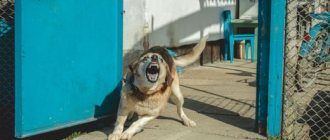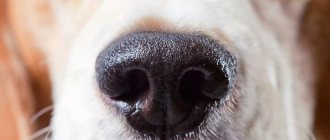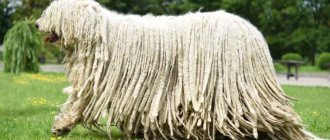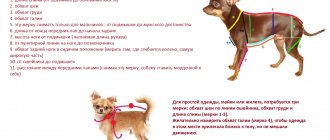The popularity of cynological courses is explained by the unique opportunity to raise a pet adapted to city life. In addition to basic disciplines, instructors tell you how to teach a dog agility. Unlike OKD, UGS and ZKS, this active discipline is aimed at developing and maintaining physical fitness, which is especially important for pets who are deprived of the opportunity to walk freely - that is, living in an apartment.
What is agility
What epithets come to mind when we think about dogs - agile, fast, jumping. Agility is a sport in which all these qualities of a dog are revealed more than anywhere else. The word “agility” is translated from English - speed, dexterity.
Agility competitions involve the participation of not only the dog itself, but also the owner or his representative. The person performing with the dog is called the handler. He guides the animal on the obstacle course, helps with commands, and corrects behavior.
The competition itself takes place in the form of an obstacle course. This is another plus for the popularity of agility, because such competitions are quite easy to organize. Typically obstacle courses should be 200 meters long. Obstacles are located on them every 10 meters.
The strip may not be straight, but in any form that the organizers come up with. This loading of obstacles allows not only the handler and his ward, but also the spectators, of whom there are many, to enjoy the process.
Basic Rules
Having learned what agility in dogs is, let's talk about the basic rules according to which competitions are held, candidates are selected and the completion of the obstacle course is assessed. We will also look at the basic terms that are used in this sport.
Terminology
Obedience is a competition based on testing dog obedience. That is, how well the pet perceives your commands, as well as the overall “guide-dog” synergy.
“Handler” is a handler, an owner who controls the dog and leads it through the strip with shells.
“Handling” is a system of professional dog shows in relevant markets.
"FCI" is an international cynological federation, which was created with the aim of developing cynology.
“Jumping” is jumping over something.
Did you know? The International Cynological Federation includes organizations from 91 countries, including Russia.
General provisions
Let's start discussing the rules from the site where the competition is held. According to the rules, the minimum dimensions of the field are 24x40 m, while the size of the ring must have a minimum size of 20x40 m. The distance between individual projectiles must be within 4-7 m.
Important! The handler must be able to get around the implement in order to supervise the dog.
Before the start of the competition, dog owners are allowed to study the course in order to draw up a plan of action. That is, each handler goes out onto the track, walks around all the equipment, while developing a sequence of actions (turns and commands).
This is followed by a formal stage, at which the judges talk with the participants, reminding them of the main idea, and also tell them about the principle of judging, evaluation and other intricacies of the conduct.
At the beginning of the competition, the participant approaches the starting line, after which the “start” command is given, and the handler, together with his pet, begins the passage. While overcoming the projectiles, the guide gives commands with words, gestures and body position. Speed, dexterity and number of errors are taken into account.
Important! Points are reduced not only because of the mistakes the dog makes, but also because of the behavior of the handler.
History of appearance
Since its inception, agility has been simply entertainment for spectators. At one of the dog shows in Great Britain, one of the organizers, John Varley, made an attempt to entertain the spectators. He wanted to show something that no one had offered before that moment. He was assisted by his friend Peter Meanwell.
Since both were fond of equestrian sports, it occurred to them to take the obstacle course as a basis from there. Some elements and obstacles were copied. Something was invented additionally, specifically for the dog.
In 1978, at an exhibition, friends first presented such entertainment to the attention of viewers. Everyone was delighted. Such competitions were repeated the next year, at another exhibition.
After a short amount of time, agility was officially recognized as one of the sports.
In Russia, the first agility championship was held in 1994. The number of participants for our huge country was very small - only 12 couples. The following year, the Russian Cup was held, the importance of the competition was emphasized by the fact that Jean Paul Petididier, the chairman of agility in the FCI sports committee, acted as the chief judge. Since 1996, Russian teams have been regular participants in the World Agility Championships.
Dogs participants
Another advantage of agility is its complete openness to dogs of all breeds. It would be more accurate to say that outbred dogs can also take part. There are no admissions in the form of pedigree or other evidence of the breed.
But restrictions still exist, although they are advisory in nature:
- age. In agility competitions, it is better to enter an animal over a year old. The skeleton of such animals and their psyche have been formed. This will help protect you from injury on the obstacle course. It is better not to bring your puppy to competitions;
- pregnancy. Pregnant bitches are not allowed to participate;
- training. Dogs must be able to comply with the handler's demands, know basic commands and be able to overcome obstacles.
Although the breed does not matter, it has been observed from experience that agility is best suited for herding breed dogs.
For convenience and for equality of tailed participants, they are divided into categories:
- “S” - small - less than 35 cm at the withers;
- “M” - medium - 35-43 cm at the withers;
- “L” – large – from 43 cm at the withers.
The competition begins with participants from the S category, then the other two in succession. This happens because some equipment on the obstacle course are adjusted specifically to the height of the participant. For example, the height of the barrier.
Based on the experience of holding competitions, certain dog breeds have already emerged that most often become winners in their categories. In the “small” category, the most successful dogs are the Spitz breed, in the “medium” Sheltie, and in the “large” category – the Border Collie. Border collies are very fast dogs. Many breeders use a trick and breed a Border Collie dog with a height that allows it to compete in overcoming obstacles in the smallest category, where it is among the leaders.
What shells are used
The International Canine Association has established the types of equipment that are used in agility. The main requirement is safety for the pet. The organizers themselves can mix them on the obstacle course in any order. It is allowed to install obstacles in any way.
All projectiles are divided into two groups:
- Assume contact with the participant;
- Does not involve contact.
Contact
- "Slide". Two planes connected in the form of an inverted “V”, the highest point is at a height of 1.5-2 meters from the ground. Wooden strips parallel to each other are attached to them, providing an anti-slip effect. The handler gives the command: “Home”, “Slide”.
- "Swing". Similar to a children's swing, on which two people ride, located at different ends. At the moment when the pet begins to move along the projectile, one of the sides moves down and the handler gives the command to move: “Swing”;
- "Boom". Unusual slide. The difference is that the shields are not connected at an angle. And between them there is a wide board along which the pet must run. In some ways the apparatus resembles a gymnastic beam. They give the command: “Boom”;
- "Tunnel". The obstacle looks like a wide pipe. The tunnel can be soft or hard. Positioned differently on the obstacle course. They give the command: “Tun” or “Bottom.”
Contactless
- "Barrier". The projectile is designed according to the principle used by track and field athletes. Two supports with a transverse bar, which is knocked down if necessary, so as not to injure the animal in the process of overcoming obstacles. The dog must pass the barrier without knocking down the bars. Command: “Jump”, “Up”, “Hop”;
- "Ring". The point of overcoming the projectile is for the dog to jump through a ring fixed to the posts. Team: “Circle”, “Tire”, “Bar”.
- "Bounce". Jumps must be performed by the dog on command, over several obstacles at once. Command: “Hop”, “Jump”, “Up”;
- "Slalom". The animal must run around twelve obstacles in the form of racks located strictly along the line. The passage is a snake. Command: "Trrr";
- "Podium-square". A square-shaped area located at a height specified for different categories, from 2 to 75 cm. The dog must jump onto this square and fixate there for a certain time: “Hop”.
Other obstacles
This group includes projectiles with which the dog interacts in various ways:
- Slalom is a series of 12 racks located on the same line, through which the dog must run in a “snake”, going around each one. For this task, the handler commands the pet to “Trrrrrrr” or “Hop.” If the latter has already been used to overcome a barrier, you need to choose another one - you cannot use the same commands in agility on fundamentally different obstacles.
- A podium (square) is a square platform raised to a height of 2-75 cm with a side one meter long, onto which the dog must run and stop for a time set by the judge (in a sitting or lying position). The square performs the same function as the podium, but is simply performed as a base area fenced around the perimeter.
Regulations
There are no clear and strict rules for agility. The evaluation criteria are also not clearly defined.
There are a number of restrictions:
- The dog should not be wearing a leash or collar while overcoming obstacles;
- the handler cannot use any means of encouragement;
- Contact between the handler and the dog on the strip must be excluded.
You cannot help your pet overcome an obstacle. Before the competition, the handler can inspect the stripes, understand where and how the obstacles are located, think through the passage, and calculate the strength of the pet.
There are two criteria for assessing exercise performance:
- cleanliness of obstacle passage;
- time.
It cannot be said that any of them is decisive. However, the cleanliness of performing exercises on the band is still more important than time.
Penalty points are awarded if:
- the dog did not meet the allotted time;
- the pet went through the wrong gate;
- contact between the handler and the dog or obstacle;
- the pet refused to work.
Fines are also imposed on the handler for negative behavior: cruelty to the pet, rudeness towards the judge.
Ultimately, the winner will be the dog that runs the entire course with the optimal cleanliness-time ratio.
Scoring and types of errors
Each organization has its own rules about what constitutes a failure and whether an attempt can be counted if there were violations. A completed run, which is completed in the minimum time with a minimum of errors, stops, etc., is considered valid. A clean mileage is a mileage without errors.
Read also: Biopsy of internal organs
For different organizations, the following actions may be considered errors:
- Time error: using more time for a run than the standard time of the lane.
- Loss of contact: the dog did not touch the contact zone with its paw while performing an obstacle with the contact zone.
- Knocked Bar: The dog moves or drops the bar while performing a jump.
- Slalom fault: entering between posts on the wrong side (the dog must start at the first post on its left), skipping a post, or moving backwards in an attempt to pass missed posts.
- Going off route: an error in the sequence of passing obstacles.
- Refusal: the dog approached the correct obstacle, but hesitated for a long time or refused to complete it.
- Pass: the dog ran past the obstacle.
- Handler error: The handler intentionally - or in some cases accidentally - touched the dog or obstacle.
- Repeat Obstacle: The handler directs the dog to repeat an obstacle it has already completed when the rules do not allow it. The penalty for this is set by the organization: the athlete may be forgiven, the team may be deducted points but allowed to continue, the athlete and dog may be allowed to finish their run but will be given the maximum obstacle course time for the duration, and so on. Some organizations have no penalty for repeating an obstacle.
- Other errors: the dog bit the judge or handler, the dog or handler exhibited unsportsmanlike behavior, the dog ran away from the ring, the athlete used toys or treats in the ring, the dog ran with a collar (in organizations that prohibit collars during racing), and so on.
Competition levels
During the obstacle course competition, the dog must receive an “Agility Certificate.” It is issued if there are three “Excellent” ratings at the first stage.
Further, the dog’s level of participation depends on previous achievements:
- Agility 1 and Jumping 1. Participants: those who are new and those who have not yet received a Certificate;
- Agility 2 and Jumping 2 Participants: those who already have a Certificate;
- Agility 3 and Jumping 3. Participants: those who have prizes for victories at previous levels and in Jumping 2, at least three.
Definition of control time (CT)
The main factor in determining the EF of the course is the speed (m/s) at which participants must cover the distance. In this case, the class of competition and the complexity of the distance are taken into account.
The movement speed is set within 1.8-3.5 m/s.
The control time in seconds is obtained by dividing the exact length of the distance by the set speed. For example: distance length is 150 m, selected speed is 2.5 m/s. KB is defined as 150:2.5=60 seconds.
How to train
An indispensable condition for a successful performance is the dog’s ability to follow commands and overcome obstacles, close contact and mutual understanding with the handler.
Classes to prepare for competitions can be conducted at home, on sites near the house, or in nature. You can make simulators so that your pet has an idea of the obstacle course that will have to be overcome.
But, of course, the best option would be training on the basis of a kennel club. There the conditions are as close as possible to competitive ones. The obstacle course in such schools and clubs completely replicates the professional ones. The pet will get used to following commands surrounded by other animals and going through trails. That is, he will gain some competitive experience. And the handler himself will gain experience of participation and understand how to correctly overcome obstacles.
The only disadvantage of classes at the club is the cost. Training lasts on average 3 hours, 1-2 times a week. The cost is usually no more than 500 rubles per lesson.
Preparation tips:
- interest your pet, training should take place in the form of a game, but with unobtrusive control;
- Offer your pet a variety of exercises to overcome obstacles. Don’t turn exercise into a routine; even the most persistent lover of running will soon get tired of the monotony;
- Never show annoyance or punish your pet for incorrectly following commands.
Briefly about the main thing
- Agility is a sport for the dog and the owner;
- The sport originated in England in 1978, Russia has been a participant in international competitions since 1996;
- A pet of any breed or a completely mongrel can become a participant;
- There are dog breeds that are more successful in this sport;
- Agility has three levels of difficulty, depending on whether the dog has a Certificate;
- You need to prepare your puppy gradually and better in a kennel club;
- There are three difficulty levels in the competition;
Is sport for everyone or are there exceptions?
It should be said that any dog can master this sport. The main thing is that its owner has a desire for this. You can practice agility even if you do not plan to prepare your pet to participate in high-level competitions. Agility itself brings great benefits not only to animals, but also to their owners . Among the variety of dogs, there are breeds that are ideal for such events:
- collie;
- Australian and Belgian Shepherds.
Those owners who have a grumpy Pekingese should not refuse the opportunity to get acquainted with agility in practice. You can start training even in your apartment. Every pet will surely love the exercises provided by the agility program. But if you start to notice that your four-legged friend manages everything quite simply, then perhaps you should start practicing this sport professionally and enroll your dog in an agility group. If you wish, you can make a full-fledged agility platform:
- You will need an open, flat clearing with an area of at least 30 x 30 m.
- Making shells will also be easy; you can find the necessary diagrams on various websites.
- Finally, all that remains is to obtain consumables, which, with some skill, will very soon turn into useful agility equipment.
The only reason why an owner would not want to practice agility with their pet is lack of time or desire. Regardless of your four-legged friend's training, you should not neglect agility classes. They have many advantages that not only you, but also your dog can appreciate:
- obedience in your pet without resorting to physical force. Classes are held in a playful way, so it is not surprising that this sport provides such good results.
- Regularity. The main disadvantage of many types of training is that after completion the dog gets bored with it. However, this will not happen with agility, the program of which involves several levels of difficulty.
- Understanding. You can improve your relationship with your four-legged friend if you do these exercises with him. Agility is especially useful for dogs that have been adopted from a shelter or have recently suffered serious psychological trauma.











